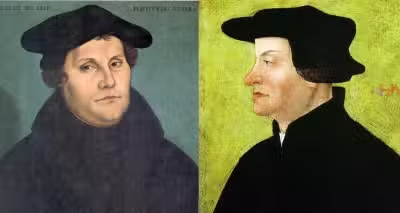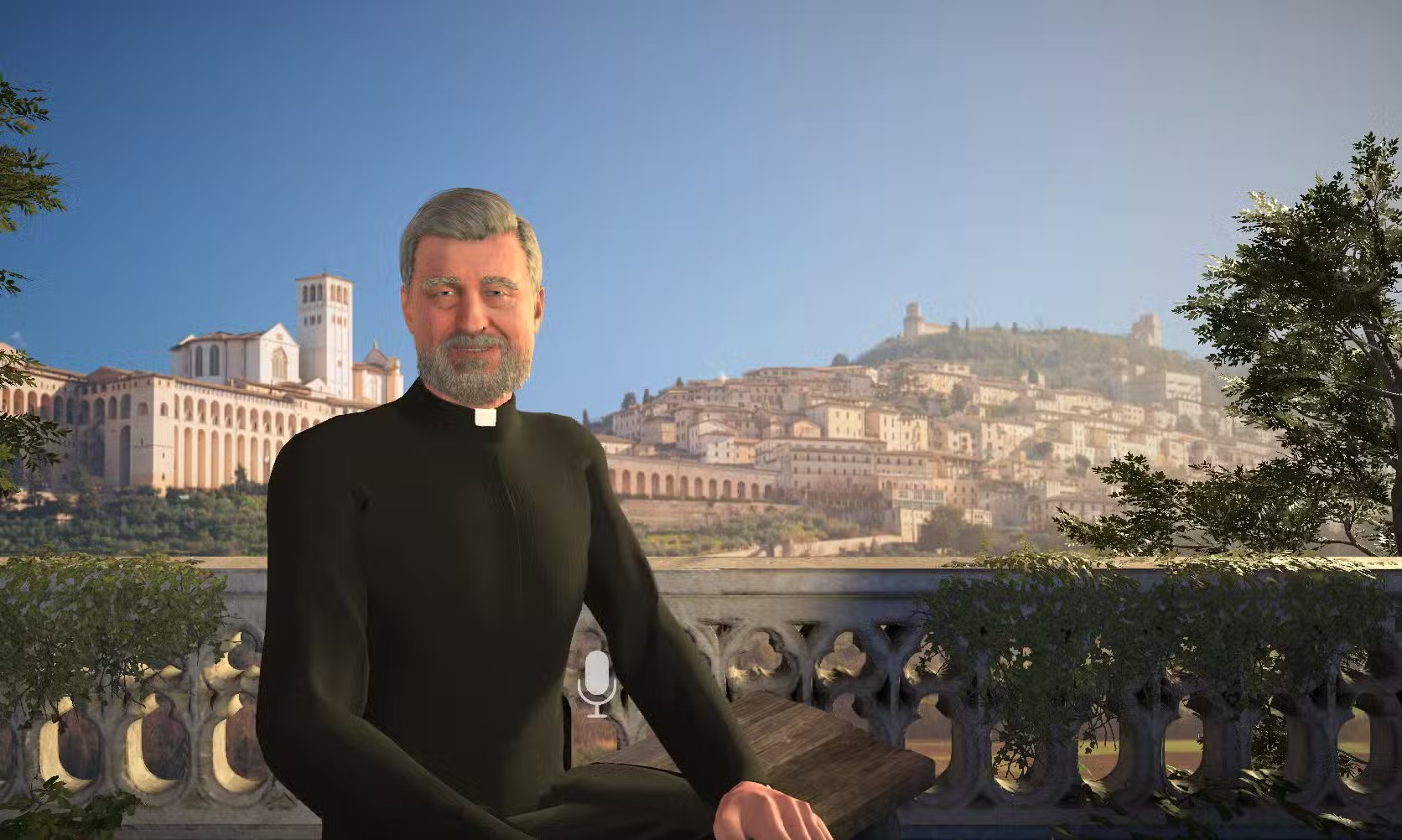So is it faith or works? When the Vatican and the Lutheran World Federation signed a historic joint declaration on justification last October, some media, notably The Wall Street Journal, declared Lutherans the victors. Back in the 1500’s Martin Luther and his followers had declared sola fide! Faith alone! Grace alone! Nothing we do can earn our salvation.
Catholics have insisted all along that salvation comes to us by God’s grace and our cooperation with it. That’s a blend of faith and works. The Wall Street Journal suggested that by signing a declaration that states, “By grace alone⦠” the Catholics recanted, admitting the error of a position defined at the Council of Trent. But the situation is more complex than that.
It starts with the question, what must I do to be holy? If I do everything right, will I be assured of holiness? Can I earn salvation? In this article we’ll take a quick look at how our role in salvation has cropped up as a question throughout Christian history. Then we’ll hear from two able spokesmen for the Catholic-Lutheran dialogue: Brother Jeffrey Gros, associate director for the U.S. Catholic bishops’ Secretariat of Ecumenical and Interreligious Affairs, and Presiding Bishop H. George Anderson, head of the Evangelical Lutheran Church in America.
Bootstrap Theology Before Boots
The question of holiness the root of the justification debate is as old as Adam and Eve. Christians, like Jews, have always agreed that woman and man were created in the image and likeness of God (see Genesis 1:26). Among Christians, though, the constant argument has been over the extent of damage done by the original parents’ sin. We are born with Original Sin; what is its effect?
Put another way, we all know from experience the gulf between how fully we love and how fully God wants us to love. Evidence abounds, within our hearts and in human society, that human nature is far short of perfection, is flawed. But how flawed are we?
The more critical question is: How do we recover from that damage? How are we saved? How are we made right in God’s eyes, or, in the language of the Reformation era, justified? Do we work our way out of bondage, or does God give us amnesty?
Some of the Church’s deepest struggles have been around this doctrine of grace. Even in New Testament times we see different approaches in response to the differing situations of the local Churches. St. Paul writes of being “righteous by faith ” in Romans 1:17 and again in Ephesians 2:4â10. Yet the Apostle James writes that faith without works is dead (James 2:17). Writing to the Galatians (5:6), St. Paul seems to strike a balance, speaking of “faith working through love. ”
St. Augustine, the “Doctor of Grace, ” forged his understanding of grace in the fifth century against Pelagius, a rigorist who held that humans can become perfect through their own efforts. Pelagianism, which some say, in today’s culture of acquisition and workaholism, never left us, is sometimes called “bootstrap theology, ” referring to the notion of pulling yourself up by your bootstraps. Pelagius, in and out of favor with bishops during his life, was ultimately condemned as a heretic at the Synod of Carthage (North Africa) in 418.
Augustine had stressed that grace God’s free gift plays the critical role in our salvation, not our actions. But the issue was by no means put to rest at Carthage. Within a hundred years a group of monks in southern France, seeking to stand out against those who were Christian in name only, adopted an extremely austere life-style. They saw the role of grace in salvation, but overemphasized the power of human will. Thus they became known as semi-Pelagians. Their views were rejected by the Synod of Orange in 529.
As Europe emerged from the Middle Ages, the issue erupted as the central issue in the argument between the Protestant reformers and the Roman Catholic Church. By Luther’s time there were many excesses in Catholic practice. Many Catholics felt that they could earn salvation in all manner of ways. Luther, probably a perfectionist in his own right, couldn’t bear the pressure of having to do so many things to remain in God’s grace. His confessor advised him to study Scripture, which he did with a passion. There he came to understand, especially in the writings of St. Paul, that God’s grace is freely given.
As he challenged the position of the Roman Catholic establishment which was surely reigning over a Church in need of reform there was misunderstanding after misunderstanding, hardened positions, and mutual, long-lasting condemnations. The Roman Catholic theological response to Luther’s fundamental criticisms came only decades later, in the Council of Trent. By then the rift between Catholics and Protestants was firmly in place.
Setting Catholic theology straight in more than a few areas, Trent acknowledged the freedom of God’s grace but insisted that our works do contribute to our salvation, though even our ability to do good works is due to God’s grace. Trent also defined Baptism’s role in fully cleansing or healing us of Original Sin (though even baptized humans still tend toward sin, and thus need continual grace, especially through the sacraments). Luther’s first followers described damaged human nature more pessimistically.
For 450 years, Lutherans and Catholics eyed each other with fear and suspicion. But during the 20th century, breakthroughs in biblical studies brought Catholic and Protestant scholars closer together. Then, too, the misery of two world wars showed everyone the futility of human divisions. Protestants began the ecumenical movement as Catholics watched from outside. Then in 1963, citing the inspiration of the Holy Spirit, Pope John XXIII convoked Vatican Council II, pressing urgently for unity among Christians, as Jesus had prayed for his disciples (see John 17:20-21). Formal dialogues began between Catholics and other Christians, including Lutherans. Thirty-three years later, on the eve of the Jubilee celebrating the 2,000th anniversary of Jesus’ birth, it was time for the Lutheran-Catholic dialogue to mark progress.
The Core of the Agreement
The Joint Declaration on the Doctrine of Justification essentially says that Lutherans and Catholics explain justification in different ways but share the same basic understanding. The central passage reads, “Together we confess: by grace alone, in faith in Christ’s saving work and not because of any merit on our part, we are accepted by God and receive the Holy Spirit, who renews our hearts while equipping us and calling us to good works. ” The declaration acknowledges that good works are a genuine response to God’s grace not the cause of it. The declaration also rescinds the formal condemnations of both the Catholic and Lutheran Churches against one another.
Date and location of the joint signing were carefully orchestrated. The ceremony took place in Augsburg, Germany, on October 31, 1999, Reformation Sunday the anniversary of Martin Luther nailing his 95 theses of protest to the church door in Wittenberg, Germany. Augsburg was chosen because it was there that Luther was confronted by Cardinal Cajetan in 1518, and there on June 25, 1530, reformers presented the Lutheran position in the presence of Emperor Charles V to Roman Catholic authorities in a futile attempt to mend the growing rift. This Augsburg Confession is considered the foundational document of Lutheranism.
At liturgy, as the congregation sang “Veni Creator Spiritus, ” the joint declaration was signed for Catholics by Cardinal Edward I. Cassidy and Bishop Walter Kasper, with the explicit approval of Pope John Paul II. Lutheran signers included Bishop Christian Krause and Dr. Ishmael Noko, representing the Lutheran World Federation, a union of 58.1 of 63 million Lutherans worldwide. Representatives of the six geographical regions of the Lutheran world signed as well. The 2.6-million-member Lutheran Church-Missouri Synod, which had contributed greatly to the Lutheran-Catholic dialogue that led to the declaration, chose not to enter into the agreement. Their leader, the Rev. A. L. Barry, accused the Lutheran World Federation of “the latest example of Lutherans sacrificing God’s truth on the altar of unity. ” In his view the Lutherans had gone too close to the Catholic position.
A Look From the Catholic Side
“The joint declaration is a key breakthrough at an authoritative level in our Church, from the Reformation. ” So says Brother Jeffrey Gros, a Christian Brother, a member of the U.S. Catholic bishops’ staff who helped forge the justification agreement.
In a St. Anthony Messenger interview, he observes that some seeds of this historic breakthrough were sown in the United States. “The homework was done here and in Germany, ” he asserts. The U.S. Lutheran-Catholic dialogue had resulted in a joint U.S. agreement about justification doctrine in 1983.
“A level of agreement was produced that made it really unnecessary for further work to be done in Germany or internationally, ” says Gros. The Evangelical Lutheran Church in America (ELCA) then contacted the Lutheran World Federation and requested that the agreement be broadened internationally. Thus the international bodies, including the Holy See, became involved. “The U.S., both theologically and institutionally, made important contributions, ” concludes Gros.
Brother Gros links the signing with Pope John Paul’s emphatic concern for moving unity forward, which has intensified at the millennium celebration. “We began the Reformation with the disagreement over justification, ” says Gros. “And we’ve only picked up this dialogue again in 1966. So we’ve begun to knit together again our faith life, or, as the Holy Father says and continues to say in Ut Unum Sint (That They May Be One, 1995), âWe share more than divides us.’ This is an instance where, in signing this joint declaration, we are, in a sense, able to say that this is no longer a Church-dividing issue. ”
He sees the joint declaration as a breakthrough that opens the doors for other aspects of Lutheran-Catholic dialogue: “Being in agreement on the issue of justification will make it easier for us to find agreement on these other issues. ” Gros notes that the declaration will likely affect the way that Catholics describe some practices that have been misunderstood in the past: “We have to, for example, understand our own belief in indulgences in light of this joint declaration, ” he suggests.
The abuse of indulgences was, of course, the last straw for Martin Luther, then a Catholic priest. Trent addressed that abuse, and Pope Paul VI further reformed Catholic teaching in this area in the 1960’s. Gros notes that indulgences are not the dominant form of Catholic piety these days. And most Catholics who are aware of indulgences don’t understand them properly, he observes. Gros says you can’t understand indulgences or any other Catholic practice “unless you understand the prior gift that we’ve received in the death and resurrection of Jesus Christ, mediated to us by grace. ”
This joint declaration provides a new opportunity to deepen our understanding of grace: “We Catholics would be renewed by this joint declaration to understand the Council of Trent better. Because we come closer to where Luther is, closer to where Paul is, and that will bring us closer to where the Council of Trent is. ”
When asked how this declaration might matter to everyday Catholics, Brother Gros is quick to point out: “It matters because it has to do with our relationship to Jesus Christ. To the extent that we’re concerned about Jesus Christ, grace and our own Baptism, it’s central to our identity. ” The very fact that Lutherans and Catholics share the centrality of God’s grace in Jesus Christ, and the centrality of our response, is of tremendous theological significance, he says. “Practically, it means that we need to better understand that we know how God’s grace works in our lives and through the sacraments, and how it relates us to other Christians. ”
Bishop Anderson: One Down, More to Go
Presiding Bishop H. George Anderson of the Evangelical Lutheran Church in America is one who actually signed the joint declaration in Augsburg last October. He stopped to talk with St. Anthony Messenger just after he had addressed the U.S. Catholic bishops at their Washington, D.C., meeting last November. (Catholic Archbishop Alexander Brunett, of Seattle, had addressed the ELCA Churchwide Assembly earlier in the year.) Bishop Anderson sees much hope in the ecumenical breakthrough: “Our relationship as two contemporary Churches Catholic and Lutheran is clouded always by the fact that these 16th-century theologians condemned the other Church on a variety of matters, and justification was one of the key ones. ”
Bishop Anderson notes that Lutherans and Catholics have been able to take steps forward in ecumenism, but always with suspicion. “There has always been the question: Are these folks on the other side (Lutheran or Catholic) really orthodox Christians or are they heretical in some way? The statement that the condemnations of the 16th century no longer apply to the Churches clears the air and provides, in the words of the pope, a cornerstone for future ecumenical progress. ” What once was a stumbling block has now become the cornerstone, observes Bishop Anderson, “a foundation on which we can build from here. ”
He foresees growing areas of unity, but there are still significant areas to be addressed. “I think we need to examine questions of ministry for example, the issue of papal infallibility on the Lutheran side, and the ordination of women from the Catholic side. Those are issues on which we now differ and we’re going to have to discuss. ”
Bishop Anderson sees these as “significant blocks, ” because each position developed in one Church apart from the other. “Lutherans decided on ordination of women, the First Vatican Council decided on papal infallibility, and we have to now ask how these Churches can deal with these separate decisions. ”
Practical Concerns
In a commentary on the joint declaration, the Holy See suggested that both Lutherans and Catholics need to “find a language which can make the doctrine on justification more intelligible also for men and women of our day. ” Both Bishop Anderson and Brother Gros see down-to-earth implications for this new acknowledgment of shared understanding. Bishop Anderson points first to the many joint celebrations of the agreement between local Lutheran and Catholic congregations: “They really were spontaneous. I think it demonstrates that both Lutherans and Catholics see this as a sign of hope, a basis for more parish cooperation in every community, big or little. ” He also points to Lutherans and Catholics joined in marriage: “This statement assures the two partners that there is an increasing common faith, that they share a common faith instead of coming at it from two separate traditions. ”
Brother Gros returns to the theme of our deepening understanding of grace. “The most important thing for us to think about when we get up in the morning is, not what we’re going to do, how we’re going to do our job, or good works in the Church, but to recognize God’s love. The reason we can do any good work is because God loves us first in grace. ” That’s what the Lutherans mean by “grace alone, ” he explains. “They don’t mean grace without anything else, but they mean grace at the center of everything.
“Every Catholic and Lutheran Christian ought to wake up thanking God for the grace they’ve received in the death and resurrection of Jesus Christ. That’s what this is about. ” You can’t be saved by money, he observes, and you can’t please God by yourself: “It’s already been done in the death and resurrection of Jesus Christ. We respond to that gift with gratitude. ”
Both sides were saying this all along, insists Gros. “We were saying it, but we weren’t thinking we were saying it. We’ve learned, both through our scholarship and also through our face-to-face dialogue, that we believe this together. ”








